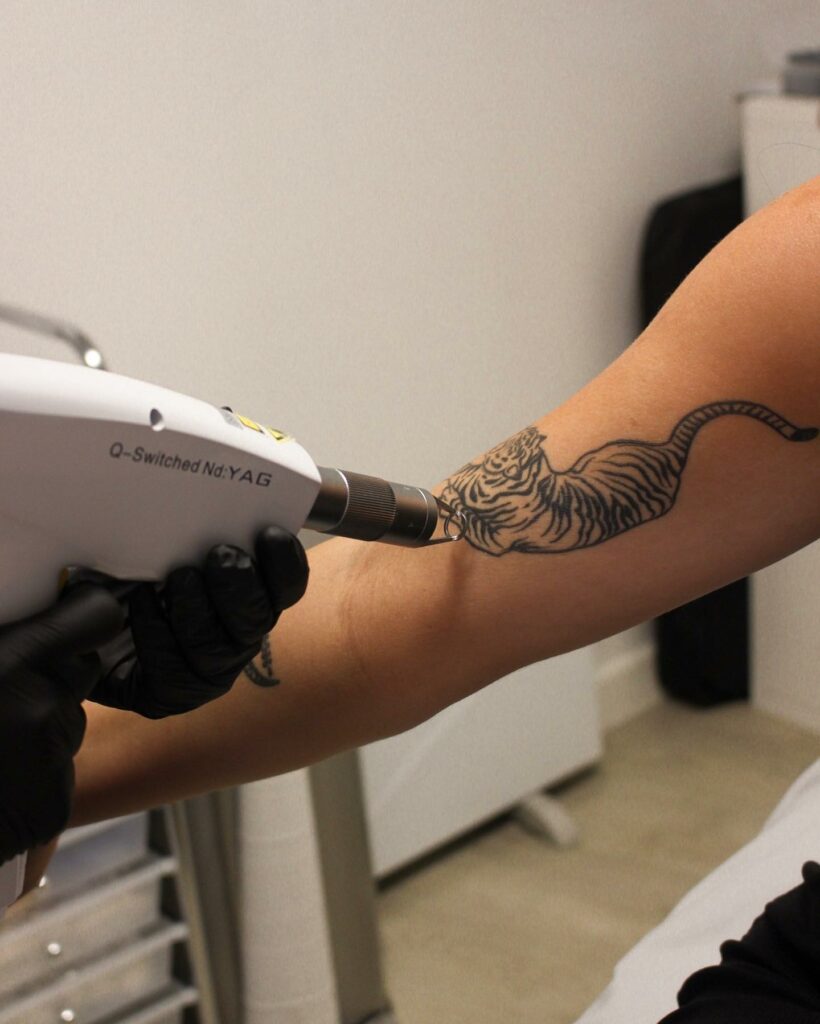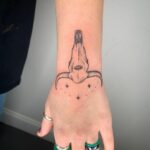Table of Contents
In this post, we’re stripping down the enigma of tattoo removal, diving deep into the healing process. You’re about to get a VIP tour behind the scenes of laser technology, immune response, and aftercare. Together, we’ll shatter some myths, hopefully saving a few of you from the perils of DIY tattoo removals (spoiler alert: bad idea!).
By the end of this journey, you’ll understand the science behind tattoo removal, how our bodies participate in this incredible process, and how to care for your skin after a removal session. Most importantly, you’ll learn how to avoid the notorious horror stories and ensure a successful healing process.

A Walkthrough of the Stages of Tattoo Removal Healing
We’ve all been there: gazing at that freshly done tattoo, blissfully unaware that one day, it might not align with our lives as perfectly as it does now. And then, one fine day, it happens. You find yourself looking into laser removal, a thought that probably makes you just as nervous as you were when you first got inked! Well, folks, let me be your ink-savvy guide through this murky labyrinth.
As a seasoned tattoo artist who’s seen her fair share of ink come and go, I’m here to offer you an insider’s view of what lies ahead. With that in mind, let’s dive into the nitty-gritty of laser tattoo removal healing. By the time we’re through, you’ll be as informed as can be, ready to face your next session with confidence.
What Happens During the Tattoo Removal Process?
First things first, the removal session itself is quick—think of the time it takes to highlight a line in your favorite book. It might be over before your favorite tune finishes playing in your headphones. The healing process, on the other hand, is a bit of a slow burn.
How the Laser Works

Before we explore the healing stages, it’s important to understand the wizardry at work during a laser removal session. Simply put, the laser serves as a magic wand that breaks down the ink so your body can naturally get rid of it.
How the Laser Breaks Down Ink
The laser removal process is a brilliant dance between cutting-edge technology and your very own immune system. You see, your body isn’t a big fan of foreign particles like tattoo ink, so it’s been trying to eliminate it since you got inked. However, the ink particles are usually too large for your immune system to handle.
Now, enter the laser. Like a crafty illusionist, it directs energy to those stubborn ink particles, causing them to shatter into smaller pieces. This makes it easier for your body’s mighty white blood cells to swoop in, gobble up those ink bits, and transport them to the lymphatic system for elimination. It’s a little bit like your immune system finally finding the right-sized wrench for a stubborn bolt!
How the Laser Affects the Surrounding Tissue
Fear not, your surrounding tissue is safe. A well-trained laser technician can adjust the laser’s wavelengths to target only the tattoo ink, leaving the rest of your skin unharmed. Think of it like precision-guided missiles—but, you know, for tattoos!
What Can I Expect Immediately After Laser Tattoo Removal?
Fresh out of your laser session, your skin might look like it had a run-in with a particularly aggressive raspberry bush. Redness, slight blistering, itching, and raised areas are all part of the package. Rest assured, these signs are all completely normal, and they should subside within two weeks.
In the first 15 minutes, the treated area may appear quite red and swollen, even slightly itchy. But as I always tell my clients, there’s no need for alarm—that’s totally normal. By the following day, any discomfort should fade away.
You might also observe a “frosting” effect on the treated skin, making it look a bit like you’ve been in a powdered sugar fight. This temporary effect is a sign that carbon dioxide is being released from your skin and typically only lasts a few minutes to half an hour after the session.
What Happens in the First Week?

The first week following your session is when the real magic happens. Your body gets to work carrying away the broken-down ink particles, allowing your skin to begin its healing process. It might still look a bit angry and red throughout this time, but that’s just your body doing its thing.
In the weeks that follow (up until about week six to eight), your body will continue to cart away some of the remaining ink. The amount will decrease incrementally each week until your next laser session. So, patience is key here, folks!
So there you have it, a comprehensive guide to the laser tattoo removal healing process. As always, it’s crucial to discuss any concerns with your laser technician. They’re there to guide you, answer your questions, and ensure your tattoo removal journey is as smooth as can be.
Healing Time Between Tattoo Removal Sessions
We’ve all got that friend who heals from a sprained ankle like Wolverine while we’re left icing ours for a week, right? Well, the same principle applies to tattoo removal. Everyone’s body, especially their immune health, reacts differently to the procedure. As your trusty tattoo expert, I’ve had customers who bounce back in no time and others who need a little longer between sessions. Remember, skin fatigue is something to be mindful of. Think of it like your skin taking a few extra deep breaths before its next tattoo removal round.
What Would Make Healing Take Longer?
Imagine this: You’re baking your favorite cake and halfway through, you just can’t resist, you dig in, ruining the perfect crust. That’s what picking at blisters or scratching the treated area is like during the healing process—you’re only prolonging it. Leaving it alone allows your body to heal naturally, avoiding any unnecessary infections or permanent scarring.
Believe it or not, lifestyle plays a huge part in the healing process too. Drinking plenty of water, maintaining an active lifestyle, and avoiding smoking can accelerate the healing process as these habits boost your immune system.
Responses to Tattoo Removal

Having laser removal can seem daunting, but knowing what to expect can ease those nerves. Let’s discuss the common responses you might experience. Don’t worry, none of them should cause alarm.
Redness
After a session, it’s common to see a bit of redness on the treated skin, much like that time I walked into a door and sported a glorious bruise for two weeks. This redness, caused by capillaries leaking into the skin, is your body’s way of saying “Hey, we’re working on it.” It helps increase blood flow to the area, which in turn flushes out the affected ink. This should fade in a week or two.
Swelling
Swelling is a totally normal response to the treatment, like how your belly might swell after a Thanksgiving feast. Most of my clients experience this right after the session and throughout the first week. If you’re unsure about the swelling, reach out to your technician. We’re here to assure you that it’s all part of the process.
Blisters
Blisters can occasionally pop up during the healing process, like unexpected guests. If they are larger than the size of a dime, your technician can help drain them. Always be aware of infection signs such as rashes, chills, or discharge. If you notice any of these, let your technician know immediately.
How Often Do These Reactions Happen?

Just like you’d trust a top-rated restaurant for your anniversary dinner, choose a reputable facility for your tattoo removal. Following your specialist’s aftercare instructions is just as important as the removal process itself. It’s a bit like a plant; you’ve got to take care of it after planting it if you want it to grow properly.
Key advice I can’t stress enough: Leave the treated area alone! Also, avoid the sun. Remember how your skin turned lobster red that time you fell asleep on the beach? We’re trying to avoid a similar scenario here. Make sure to apply sunscreen or cover the area.
Keep the area clean and dry for the first day. You can apply a thin layer of hydrocortisone cream once a day for the first five days, and though a relaxing bath might sound appealing, avoid submerging the area in water.
A Summary Of The Risks
Laser tattoo removal is a generally safe procedure, but like any medical treatment, it does come with potential risks or complications. Here are some of them:
- Incomplete removal of the tattoo: Not all tattoos can be completely removed. Some colors are harder to remove than others, and certain types of inks can be particularly resistant to laser treatment. The age, size, and location of the tattoo, as well as the individual’s skin type, can also impact the removal success.
- Changes in skin texture: The treated area might show changes in texture, becoming either thicker or thinner compared to the surrounding skin.
- Hyperpigmentation or hypopigmentation: After laser tattoo removal, the skin can sometimes either become darker (hyperpigmentation) or lighter (hypopigmentation) than the surrounding skin. This is more common in individuals with darker skin tones. Most of the time, these color changes are temporary but they can occasionally be permanent.
- Infection: As with any procedure that disrupts the skin, there is a risk of infection. However, this risk is minimized when proper aftercare procedures are followed.
- Scarring: There’s a risk of scarring from the laser treatment, although this is relatively rare if post-treatment care instructions are followed carefully.
- Allergic reactions: In some cases, the laser can trigger an allergic reaction to the tattoo ink.
- Blistering and scabbing: These are part of the normal healing process after laser tattoo removal but if not cared for properly, they can potentially lead to infection or scarring.
It’s essential to consult with a professional tattoo removal specialist before undergoing the procedure, to understand the risks and potential complications associated with your specific case. Additionally, following aftercare instructions diligently can significantly reduce the risks associated with laser tattoo removal.
Conclusion
As we ink our personal stories onto our bodies, it’s important to remember that tattoo placement and cost are key considerations. Whether it’s a discreet symbol on the ankle or a bold statement on the forearm, the location of a tattoo often carries as much weight as the design itself. And while we may be tempted to opt for a bargain, it’s crucial to remember that quality work comes at a price—investing in a skilled artist is investing in the longevity of your tattoo and your skin health.
However, as with any procedure, potential negatives can arise. From redness and swelling to the rare occurrence of infections, it’s important to be prepared. But let’s not forget, most of these reactions are part of the natural healing process, and with proper aftercare, are temporary. At the end of the day, we’re all uniquely human with individual healing timelines and reactions. Armed with the right knowledge and expert guidance, we can navigate the world of tattoos and tattoo removals confidently, making our body art journey an exciting and fulfilling one.




